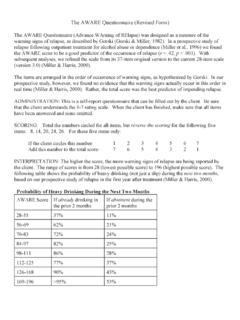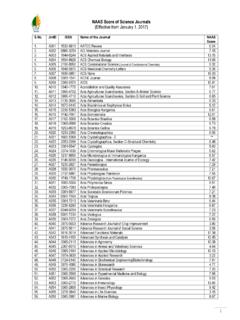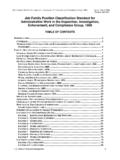Transcription of Revised Global Scales: Motivational Interviewing Treatment ...
1 Draft Manuscript: Do Not Quote Without Author s Permission 1 Revised 22 january 2010 (minor text revisions) Revised Global Scales: Motivational Interviewing Treatment Integrity (MITI ) Moyers, T. Martin, Manuel, Miller, & D. Ernst University of New Mexico Center on Alcoholism, Substance Abuse and Addictions (CASAA) Author Note: The Motivational Interviewing Treatment Integrity (MITI) Code is an instrument-in-development. We are making it available now for use in research and scholastic endeavors, and we expect that many improvements will be needed before this coding system is complete. If you find errors, inconsistencies or have suggestions for improvement or other feedback, please contact us. We look forward to improving the MITI, with your help. Theresa Moyers, Draft Manuscript: Do Not Quote Without Author s Permission 2 Revised 22 january 2010 (minor text revisions) Learn, compare, collect the facts!
2 Pavlov 1849-1936 How well or poorly is a practitioner using Motivational Interviewing ? The MITI is a behavioral coding system that provides an answer to this question. The MITI also yields feedback that can be used to increase clinical skill in the practice of Motivational Interviewing . The MITI is intended to be used: 1) as a Treatment integrity measure for clinical trials of Motivational Interviewing and 2) as a means of providing structured, formal feedback about ways to improve practice in non-research settings. It should be noted that the MITI and its parent instrument, the Motivational Interviewing Skills Code (MISC), are not competing instruments for the same task. They are different tools designed to accomplish different tasks. The MISC is typically more useful in conducting detailed process research investigating the critical elements and causal mechanisms within Motivational Interviewing .
3 It cannot be replaced by the MITI for these purposes. Alternatively, the MITI may be more useful when a simpler question is posed (how much is this Treatment like Motivational Interviewing ?) or when more targeted feedback is needed (how can our clinicians improve in their use of Motivational Interviewing ?) for training. Specific differences between the MITI and the MISC are: 1) The MISC provides a comprehensive examination of interviewer and client behaviors, as well as the interaction between the two, while the MITI measures only interviewer behaviors. 2) The MISC may require up to three separate reviews or passes of the tape segment, while the MITI typically uses a single pass. 3) The MISC captures dimensions of the client s readiness to change and commitment language, while the MITI does not. Such client behavior can be important in predicting outcomes. 4) The MISC is a mutually exclusive and exhaustive coding system, but the MITI is not.
4 Many specific behaviors that are coded in the MISC are collapsed into a single category in the MITI, or left uncoded entirely. The MITI is not a complicated coding system that can detect expert or particularly sophisticated use of Motivational Interviewing . The MITI is designed to be used as a Treatment integrity measure and as a means of providing feedback. While more in-depth and detailed coding systems do exist, they are rarely used because of the cost and time involved in coder training and session coding. We have noticed that expert users of MI are sometimes frustrated by the MITI, particularly when they are attempting to use it for improving clinical practice. We are often queried about the possibility of altering or adding to the MITI. Usually this occurs in the context of a supervisor who would like to tap dimensions of MI practice that are not present in the MITI. While we sympathize, we also note that these more complicated dimensions of MI practice (which may be added) will not meet the rigorous criteria of reliability and validity that comes from using an empirically-validated instrument like the MITI.
5 There is a reason why the MITI is simple and that is because more complicated elements of clinical practice are very difficult to capture reliably. We do not prevent individuals from altering or adding to the MITI, but our advice would be to make it clear that such alterations may or may not give the same reliable information that can be obtained from using the MITI as we have published it here. Draft Manuscript: Do Not Quote Without Author s Permission 3 Revised 22 january 2010 (minor text revisions) A. COMPONENTS OF THE MITI The MITI has two components: the Global scores and the behavior counts. A Global score requires the coder to assign a single number from a five-point scale to characterize the entire interaction. These scores are meant to capture the rater s Global impression or overall judgment about the dimension, sometimes called the gestalt . Five Global dimensions are rated: Evocation, Collaboration, Autonomy/Support, Direction, and Empathy.
6 This means that each MITI review will contain five Global scores. A behavior count requires the coder to tally instances of particular interviewer behaviors. These running tallies occur from the beginning of the segment being reviewed until the end. The coder is not required to judge the quality or overall adequacy of the event, as with Global scores, but simply to count it. Typically both the Global scores and behavior counts are assessed within a single review of the tape, and typically a random 20-minute segment is used. Careful attention should be paid to ensuring that the sampling of the tape segments is truly random, especially within clinical trials, so that proper inferences about the overall integrity of the MI intervention can be drawn. The tape may be stopped as needed, however excessive stopping and restarting in actual coding (as opposed to training or group review) may disrupt the ability of the coder to form a gestalt impression needed for the Global codes.
7 Coders may therefore decide to use two passes through the tape until they are proficient in using the coding system. In that case, Pass One should be used for the Global scores and Pass Two for the behavior counts. B. DESIGNATING A TARGET BEHAVIOR An important component of using Motivational Interviewing well involves the interviewer s attention to facilitating change of a particular behavior or problem. Skillful interviewers will attempt to reinforce and elicit client change talk about that specific change when they can. Coders should know, in advance of the coding task, what is the designated target behavior for the intervention, assuming that there is one. This will allow coders to judge more accurately whether the clinician is directing interventions toward the target behavior, is floundering or hopelessly lost. The MITI is not designed to be used for interventions in which a target behavior cannot be identified.
8 C. Global SCORES What is the short meaning of a long speech? Schiller (1759-1805) Global scores are intended to capture the rater s overall impression of how well or poorly the interviewer meets the intent of the scale. While this may be accomplished by simultaneously evaluating a variety of elements, the rater s gestalt or all-at-once judgment is paramount. The Global scores should reflect the holistic evaluation of the Draft Manuscript: Do Not Quote Without Author s Permission 4 Revised 22 january 2010 (minor text revisions) interviewer, one that cannot necessarily be separated into individual elements. Global scores are given on a five-point Likert scale, with the coder assuming a beginning score of 3 and moving up or down from there. In the MITI , the Spirit Global rating has been parsed into three Global ratings: Evocation, Collaboration, and Autonomy/Support. These ratings are not orthogonal; rather they may be related and influenced by each other.
9 Evocation, Collaboration, and Autonomy/Support are averaged together to yield a Spirit Global . It is recommended that you average to two decimal points. Draft Manuscript: Do Not Quote Without Author s Permission 5 Revised 22 january 2010 (minor text revisions) Evocation Low High 1 2 3 4 5 Clinician actively provides reasons for change, or education about change, in the absence of exploring client s knowledge, efforts or motivation. Clinician relies on education and information giving at the expense of exploring client s personal motivations and ideas. Clinician shows no particular interest in, or awareness of, client s own reasons for change and how change should occur. May provide information or education without tailoring to client circumstances. Clinician is accepting of client s own reasons for change and ideas about how change should happen when they are offered in interaction.
10 Does not attempt to educate or direct if client resists. Clinician works proactively to evoke client s own reasons for change and ideas about how change should happen. This scale is intended to measure the extent to which the clinician conveys an understanding that motivation for change, and the ability to move toward that change, reside mostly within the client and therefore focuses efforts to elicit and expand it within the therapeutic interaction. Low on Scale Clinicians low on this scale have only superficial interest in the client s ambivalence or reasons for change, and miss opportunities to explore these in detail. They may make assumptions about the client s intent to change (or not change) without exploring this in detail, or may ignore the client s ideas when they are offered. Clinicians low in Evocation may rely on persistent fact gathering or information-giving as a means of facilitating change, and often convey a distrust of the client s current knowledge base about the problem under consideration.

















